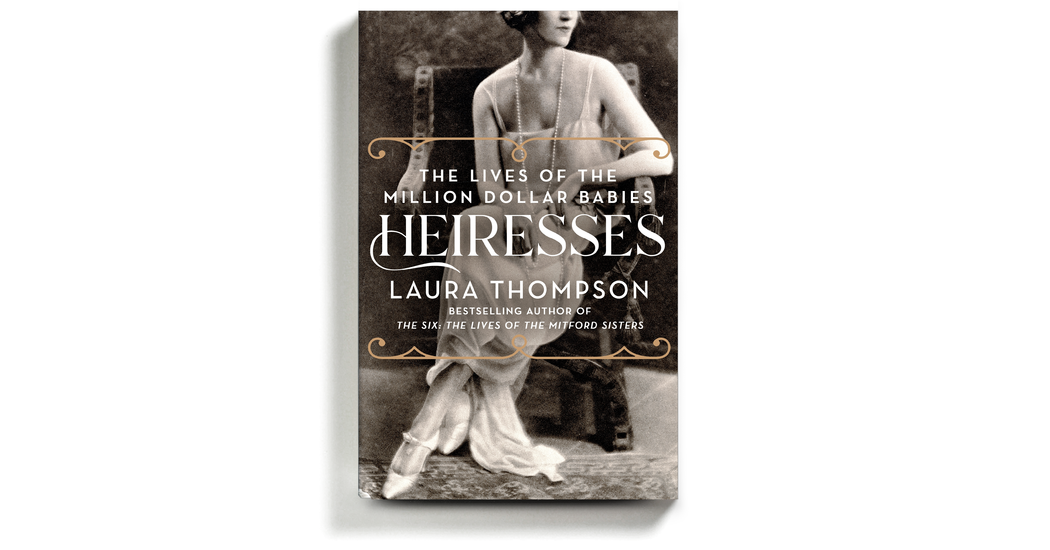Ranging from the 17th century to the 21st, Laura Thompson’s book examines the lives of ostensibly fortunate daughters.
HEIRESSES
The Lives of the Million Dollar Babies
By Laura Thompson
Illustrated. 378 pages. St. Martin’s Press. $29.99.
You might think that being an heiress is all fun and games — actual games, like whist, or tag in a topiary maze — but to read Laura Thompson’s new book, “Heiresses: The Lives of the Million Dollar Babies,” is to apprehend two serious risks you may not have considered: 1) getting kidnapped and 2) boredom.
We’re not talking about a little mild ennui (Anglo-American heiresses, the focus of Thompson’s scrutiny, often prefer French words, like “le gratin” for high society or “bel homme” for a particularly toothsome man). This is a mal de vivre so deep that it might induce one to receive guests from the bath while wearing a cellophane cape, keep a lion cub as a lap pet or something more dramatic, like shoot one’s lover and oneself with a pearl-handled revolver. Anything to vary the days, alleviate “the ineffable melancholy, the shadowless sameness” of being financially solvent through a mere accident of birth.
Heirs, of course, have their share of problems; several Gettys spring to mind, including John Paul Getty III and his severed ear. But “female stories have an extra dash of piquancy,” Thompson argues — citing the uncommon spectacle of Patricia Hearst, the newspaper scion famously abducted in 1974, wielding a semiautomatic weapon — and “a prurience.” They also tend to feature better jewels, like the cherry-size baubles Margot Liddon Flick Hoffman gave to her “grande horizontale” of a lover, with whom she bought a palazzo in Venice. Maud Burke of San Francisco, who married into the Cunard shipping family, liked jewels so much that she renamed herself Emerald. Barbara Hutton favored a string of black pearls once owned by Louis XIV’s mother.
Thompson, who has written biographies of Agatha Christie, the six Mitford sisters, a few of whom make cameos here, and (returning for more) Nancy Mitford, spreads herself far more thinly with the organizing principle that “it really is different for girls.” Her well-informed but slightly breathless narrative ranges from the 17th century to the 21st, crisscrossing continents as if on the Concorde rather than one of Cunard’s pokey liners, and her choice of which “female stories” to tell can feel somewhat arbitrary. We spend quite a bit of time with Consuelo Vanderbilt, for example, and her godmother, who was the model for a character in Edith Wharton’s “The Buccaneers” — Thompson is a skilled literary analyst — but Huguette Clark, the copper scion and painter who abandoned her mansions for hospitals, dying at 104, isn’t mentioned. Other well-known figures, like Doris Duke and Sunny von Bülow, are crammed fleetingly into footnotes. This is not so much an encyclopedia of heiresses as a starter pack.
With diligence and proper indignation, Thompson shows how, long before Hearst’s ordeal hit the airwaves, these ostensibly fortunate daughters had an inherent vulnerability. Marriage was, for many years, tantamount to losing their property. Men were gaslighting them before gaslight was even invented. Mary Davies, whose real estate holdings became the foundation for some of the poshest parts of London, had an apparently happy union of more than two decades with Sir Thomas Grosvenor — still, she was only 12 when it commenced, and was victimized by ghastly schemes after he died. Heiress-snatching would go on to become “an activity almost for its own sake, a modish crime.” It’s a relief when “the slim ghost of feminism” turns up in the 1900s, like the return of the vengeful wife in Noël Coward’s “Blithe Spirit.”
Even after women secured more legal rights, Thompson writes, heiresses remained tragedy magnets; “hungry for hunger,” some developed actual eating disorders, turned to drugs or prostrated themselves for love. Why so glum? wonders Thompson, an obviously hard-working author who admits to envying the very wealthy, fantasizing about how to spend all that dough: “I have itemized the house on Cheyne Walk, the apartment on the Upper East Side, the cryogenic chamber, the Stubbs, the fittings at Givenchy, the animal sanctuary. Would all that make me happy? Well: to be honest, I think it might.”
She has the consolation of history, at least, moving on from ghastly scenes of teens whisked to Gretna Green, Scotland — the Las Vegas of its time — to upstart Americans with fresh new money from railroads, baking powder and the like, eager for the finishing touch of an English title and ready to fix — and raise — the roof of the “ancestral pile.” Neglectful parenting abounds; one heiress supposedly admires three little girls minded by a nanny, in Hyde Park — not realizing they’re her own children. We feel the goose bumps on exposed arms in “arctic drawing rooms,” and smell the exquisitely distilled fumes of leisure in the Newport dwellings of people like the Astors: “(bay rum, Floris scent, thoroughbred horseflesh).”
Thompson’s sly asides, often in parentheses, can make her seem like a marquise at the party, behind her fan. She strives mightily to connect heiresses, a somewhat antiquated concept, to the present, which sometimes misfires, like when she writes that Hutton was “shooting herself in the Blahniks” by divorcing Cary Grant in 1945. (Dahling, please! Manolo Blahnik, the shoe designer, was then only a toddler.) And this book about “million-dollar babies” has a lot of million-dollar words: etiolated, accidie, budgerigar.
Trapped in a silk-draped Venn diagram with the socialite and hostess, the heiress has been an unfair object of ridicule. After years of getting dragged through the tabloids and trotted out on reality shows like one of her beloved show ponies, she is both restored to dignity by Thompson’s concerned embrace and pushed away with an air kiss. It’s a complicated romp.


























